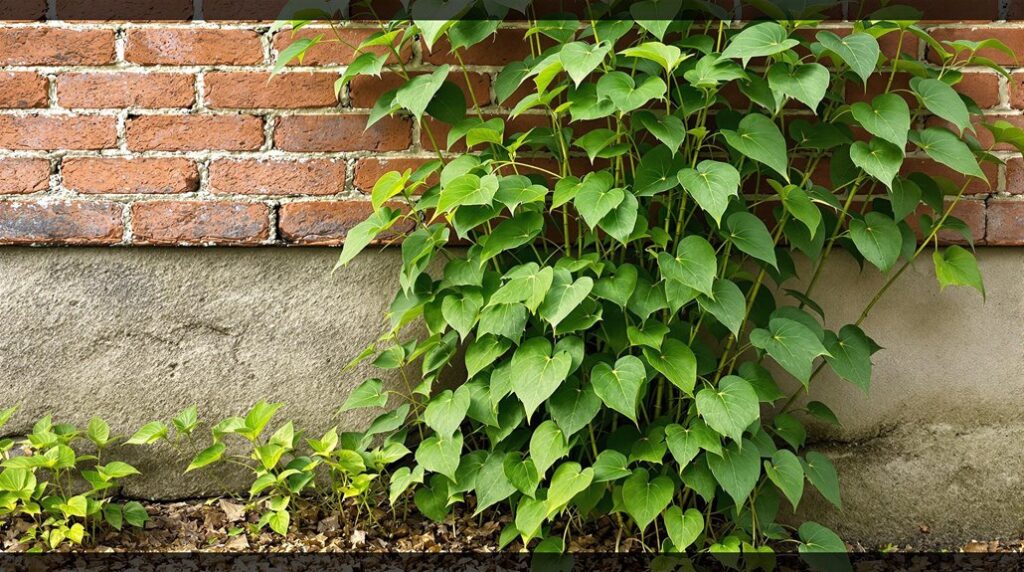I’ve seen homeowners lose thousands of dollars because they ignored those bamboo-like shoots growing near their foundation. What looks like harmless greenery can actually be Japanese knotweed—a plant that’ll damage your property’s structure and slash its value by up to 15%. The problem isn’t just the plant itself, but the costly mistakes people make when they can’t properly identify it. Before you grab your garden shears and make an expensive error, you need to understand what you’re actually dealing with.
Key Takeaways
- Japanese knotweed can reduce property values by 5-15% due to buyer stigma and mortgage restrictions.
- Early detection in spring is crucial—look for red asparagus-like shoots and spade-shaped leaves near borders.
- Professional removal requires 3-5 seasons of herbicide treatments with insurance-backed guarantees for effective eradication.
- DIY removal often worsens infestations by fragmenting rhizomes, creating more plants and increasing liability risks.
- Undisclosed infestations increase sale collapse rates from 7% to 26% and may trigger legal claims.
What Is Japanese Knotweed and Why Should You Care?
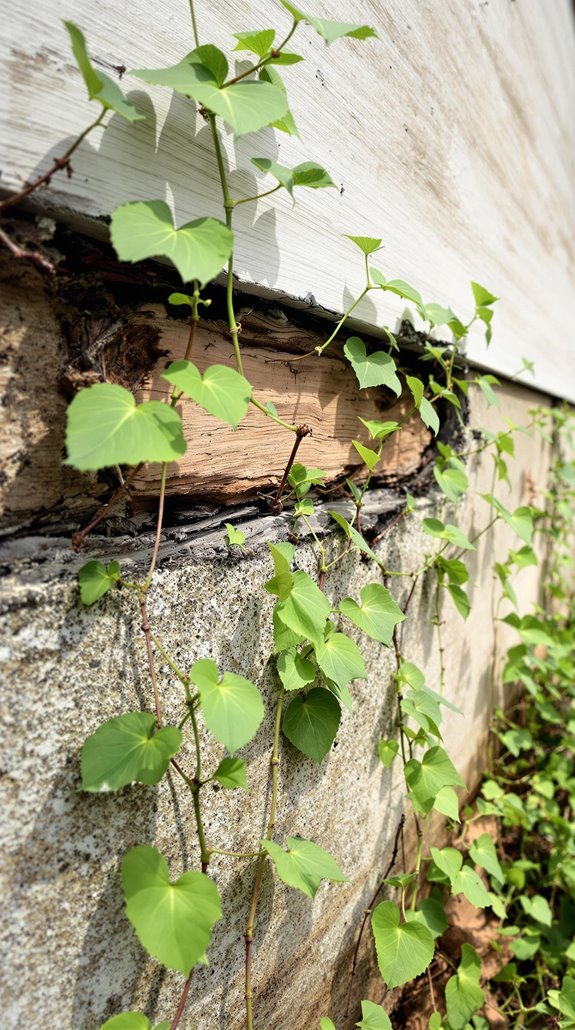
Japanese knotweed doesn’t look threatening at first glance, but this seemingly innocent plant poses one of the most serious invasive species challenges you’ll face as a property owner. I’m talking about a herbaceous perennial that forms dense clumps up to 15 feet tall with distinctive bamboo-like hollow stems and reddish-purple coloration. Those shovel-shaped leaves might seem harmless, but they’re attached to an underground network of rhizomes that can spread 65 feet horizontally.
Here’s what makes this plant your enemy: it grows 8 centimeters daily, fragments as small as 0.7 grams can sprout new plants, and those rhizomes will crack your concrete and foundations. Without natural predators, it’ll dominate your landscape, reduce your property value by 15%, and cost thousands to remove. This invasive species has already established itself in 42 U.S. states, making it one of the most widespread botanical threats across the country.
The Real vs. Perceived Threat to Your Property Structure
While property owners often panic at the sight of Japanese knotweed near their homes, the actual structural damage this plant causes is far less dramatic than social media horror stories suggest. I’ve reviewed the research, and only 2-6% of cases show any structural damage correlation. Studies of 68 abandoned properties with heavy infestations found no plant-caused damage.
Here’s what you need to know: Japanese knotweed exploits existing cracks in foundations and brickwork, but it doesn’t create them. Your solidly built home faces no greater risk from knotweed than from other plants. The real threat isn’t your walls—it’s your property value, which typically drops 5-15% due to market perception alone. However, in extreme cases, property values have plummeted from £305,000 to just £50,000, demonstrating how market perception can create devastating financial consequences. Don’t let fear drive expensive decisions without understanding the facts.
How Japanese Knotweed Actually Spreads Around Your Home
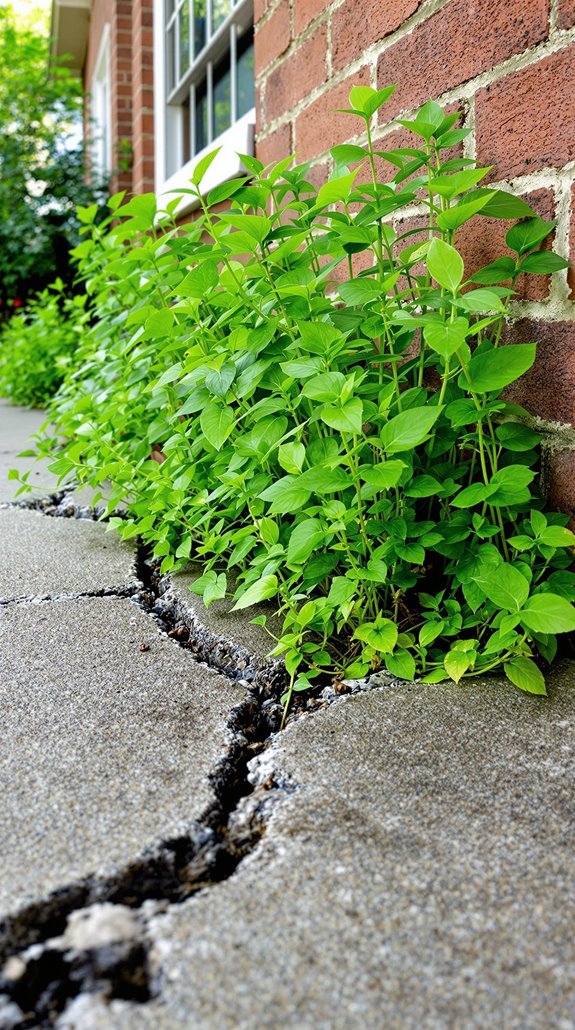
Understanding the real structural risks helps you make informed decisions, but knowing how this invasive plant actually spreads around your property is what prevents small problems from becoming expensive nightmares.
I’ll be direct: you’re likely spreading Japanese knotweed yourself without realizing it. Every time you disturb soil within 7 meters of visible growth, you’re fragmenting rhizomes that extend horizontally up to 7 meters and 3 meters deep. That 2mm fragment clinging to your spade? It’ll regenerate into a new plant.
Your biggest threats aren’t seeds—UK populations can’t produce viable ones. Instead, it’s moving contaminated soil, improper waste disposal, and construction activities. When you cut stems or excavate carelessly, you’re creating fragments that remain dormant for years before sprouting elsewhere on your property. Even animals can spread Japanese knotweed through their faeces, particularly after consuming above-ground stems and crowns during spring and summer months.
Common Plants Mistaken for Japanese Knotweed
How many times have you spotted what looks like Japanese knotweed, only to discover it’s actually a harmless garden plant? You’re not alone in this confusion. Several common plants share similar features with Japanese knotweed, leading to frequent misidentification.
Bindweed, with its heart-shaped leaves and climbing habit, lacks knotweed’s distinctive bamboo-like stems. Russian Vine grows as a tall climber but doesn’t produce the same rigid canes. Himalayan Honeysuckle features opposing leaf pairs and produces berries, unlike knotweed’s alternate leaf pattern.
Houttuynia, often called “Chameleon plant,” spreads rapidly but stays low to the ground. Broad Leafed Dock forms ground-hugging rosettes with distinctive flower spikes. Ground Elder can be particularly confusing as it produces tiny white flower umbels and spreads via rhizomes similar to Japanese knotweed.
I’ve found that focusing on knotweed’s unique hollow, bamboo-like stems and shield-shaped leaves helps distinguish it from these lookalikes.
The Hidden Costs of Misidentification and False Alarms
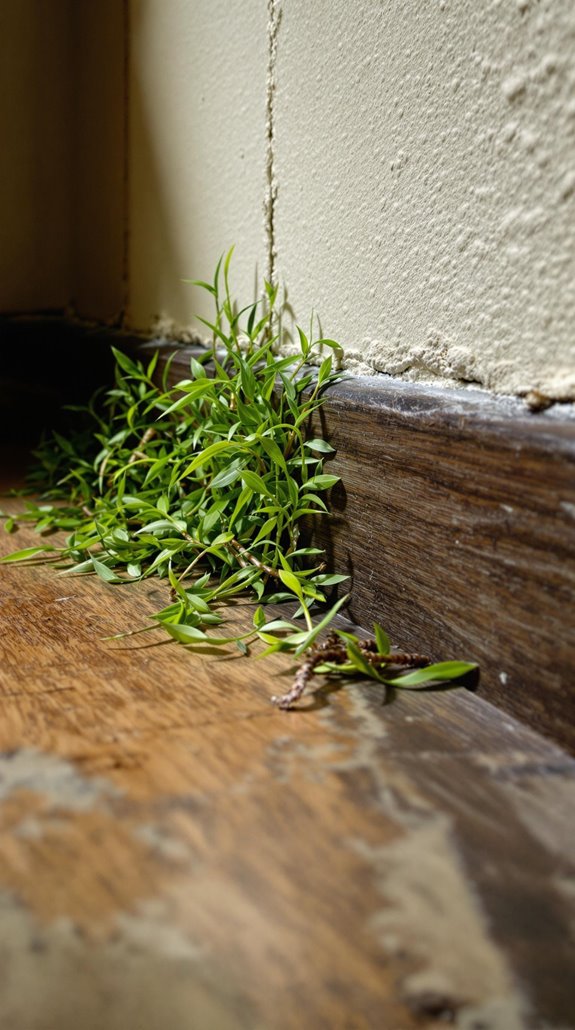
When homeowners mistake harmless plants for Japanese knotweed, they’re often unprepared for the cascade of financial consequences that follow. I’ve seen property owners spend thousands on unnecessary treatments and specialist assessments that average £300–£1,000 per inspection. These false alarms trigger mortgage delays, sometimes causing sales to collapse entirely when buyers withdraw after unsubstantiated reports.
The ripple effects extend far beyond immediate costs. Your property value can drop up to 5% even after proving misidentification, while insurance premiums increase due to erroneous records. I’ve witnessed conveyancing bottlenecks that extend marketing periods, inflating holding costs and shrinking your buyer pool. The confusion stems from the fact that bindweed misidentification accounts for the largest portion of incorrect plant submissions by concerned homeowners.
Legal disputes compound these expenses, with failed compensation claims generating litigation costs that often exceed any potential recovery. Proper identification protects your investment.
Understanding Growth Patterns and Containment Distance
Beyond the financial pitfalls of misidentification lies a more pressing concern: Japanese knotweed‘s aggressive growth patterns that can devastate your property within a single growing season. I’ve witnessed this invasive plant grow 8 cm daily during summer months, reaching 3 metres by late July. What you can’t see is the real threat—underground rhizomes spreading 7 metres laterally and penetrating 3 metres deep, cracking foundations and displacing pipes.
Here’s what you need to know: establish a minimum 7-metre buffer zone around any infestation. Install physical barriers extending 3+ metres deep to block rhizome access. Don’t underestimate this plant’s regenerative power—fragments as small as 0.7 grams can spawn new colonies. The plant’s resilient rhizome system stores energy reserves that enable it to survive harsh conditions and fuel rapid regrowth, making complete eradication extremely challenging without professional intervention. Understanding these patterns helps you protect your investment before structural damage occurs.
Legal Risks and Property Value Impact
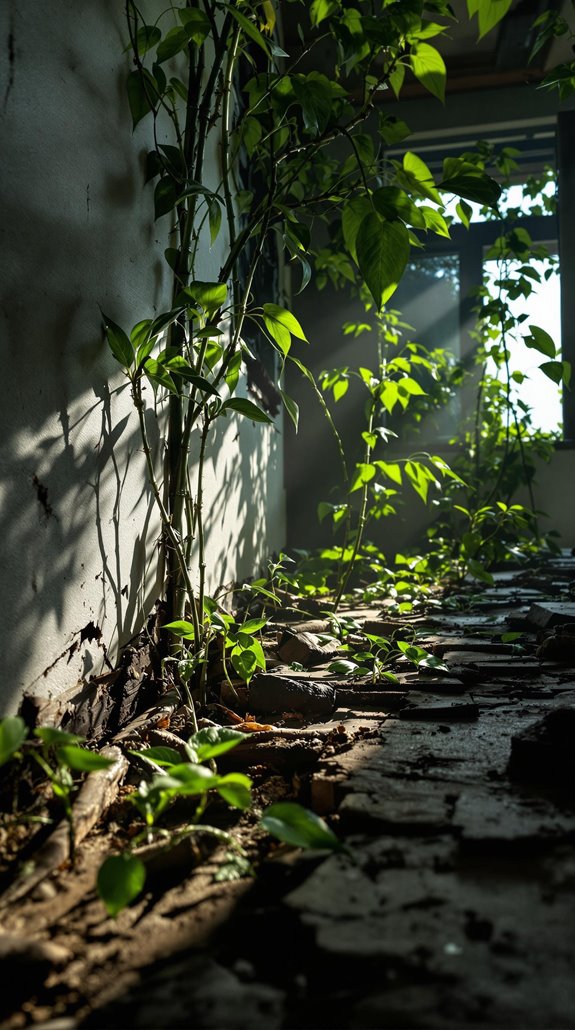
While Japanese knotweed‘s physical spread creates immediate property risks, the legal and financial consequences can devastate your investment long before structural damage occurs. I’ve seen properties sell for just 93.1% of asking price when knotweed’s present, with values dropping up to 15% due to buyer stigma alone.
Your mortgage options disappear quickly—banks refuse lending until you’ve secured professional treatment with insurance-backed guarantees. Even worse, if knotweed spreads to neighboring properties, you’ll face private nuisance claims covering their devaluation and eradication costs.
The legal precedent is clear: courts hold homeowners liable for cross-boundary spread. Sales collapse rates jump from 7% to 26% when buyers discover undisclosed infestations. Don’t let stigma destroy your property’s value—act before legal complications multiply your costs. Professional treatment remains the only reliable solution, as DIY removal attempts often worsen the problem and create additional liability risks.
Professional Removal Methods That Actually Work
After witnessing countless DIY failures that spread infestations further, I’ll show you the professional methods that actually eliminate Japanese knotweed permanently.
The most effective approach combines herbicide stem injection with systematic cutting cycles. Certified technicians inject glyphosate directly into hollow stems during late growing season, maximizing root translocation while minimizing environmental impact. This targets the extensive rhizome network that DIY surface treatments can’t reach.
Professional plans require 3-5 seasons of repeated applications, with weekly shoot removal between cycles to exhaust root reserves. For severe infestations, excavation removes woody rhizome clusters up to 1-foot diameter, followed by soil screening and root barrier installation. The plant’s invasive nature has allowed it to establish in over 42 U.S. states with no natural predators to control its spread.
What sets professionals apart is their monitoring systems—quarterly inspections for three years, digital progress tracking, and insurance-backed guarantees that satisfy mortgage lenders.
Early Detection Strategies for Homeowners
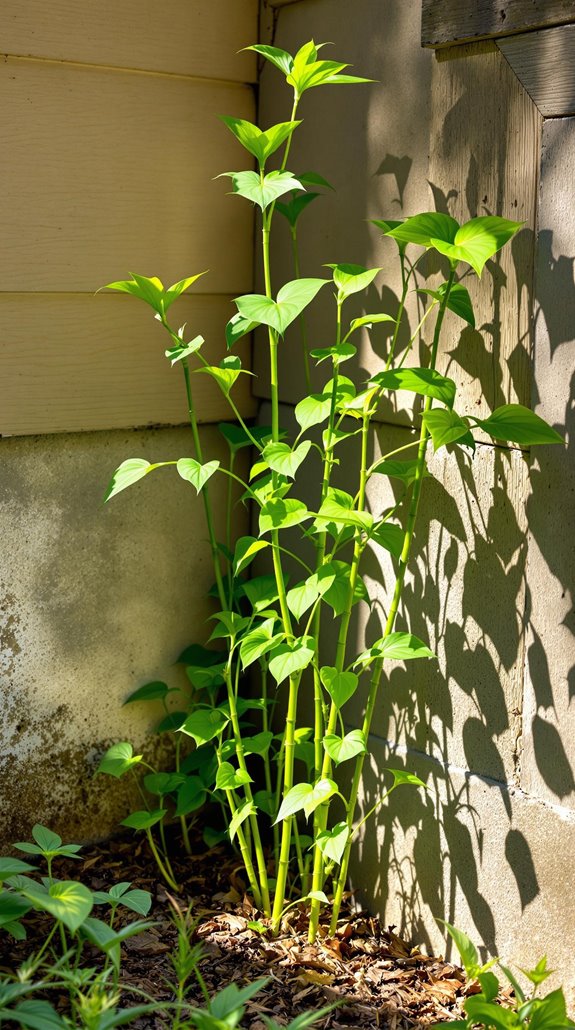
Professional removal works best when Japanese knotweed hasn’t spread beyond containment, which makes early detection your first line of defense. I’ll help you spot this invasive plant before it becomes a nightmare.
Spring’s your prime detection window. Look for small red shoots emerging like asparagus tips—that’s your earliest warning sign. As they grow rapidly (up to 10cm daily), you’ll notice distinctive spade-shaped leaves with flat bases where stems meet leaves, not heart-shaped like giant knotweed.
Focus your search on high-risk zones: garden borders, fence lines, cracked driveways, and areas near drainage. The telltale zigzag pattern in stems becomes obvious by mid-summer, while late summer brings creamy white flower clusters.
If you spot something suspicious, photograph it immediately and avoid disturbing the area until professionals verify it. Remember that underground rhizomes can extend several metres from the parent plant, meaning the visible growth might only represent a fraction of the actual infestation.
Conclusion
I can’t stress enough how essential it is to act fast if you suspect Japanese knotweed on your property. Don’t wait for it to establish itself—I’ve seen too many homeowners face devastating costs from delayed action. Get professional identification first, then immediate treatment if confirmed. Yes, professional removal isn’t cheap, but it’s nothing compared to structural damage or losing 15% of your property value. Your future self will thank you for acting decisively now.
References
- https://pmc.ncbi.nlm.nih.gov/articles/PMC6064201/
- https://aecom.com/uk/press-releases/ecologists-find-no-evidence-japanese-knotweed-causes-significant-structural-damage/
- https://thorntonandlowe.com/new-data-on-japanese-knotweed/
- https://www.propertymark.co.uk/resource/data-shows-japanese-knotweed-consistently-mistaken.html
- https://www.ceh.ac.uk/our-science/case-studies/japanese-knotweed-and-property-market
- https://www.in.gov/dnr/files/Japanese_Knotweed.pdf
- https://nyis.info/species/japanese-knotweed/
- https://www.invasivespeciescentre.ca/invasive-species/meet-the-species/invasive-plants/japanese-knotweed/
- https://japaneseknotweed.co.uk/japanese-knotweed/
- https://fieldguide.mt.gov/speciesDetail.aspx?elcode=PDPGN0L0U0

